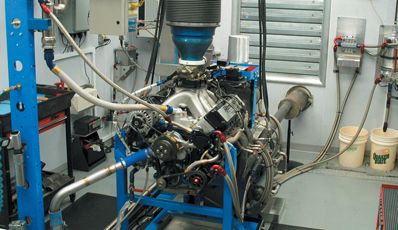
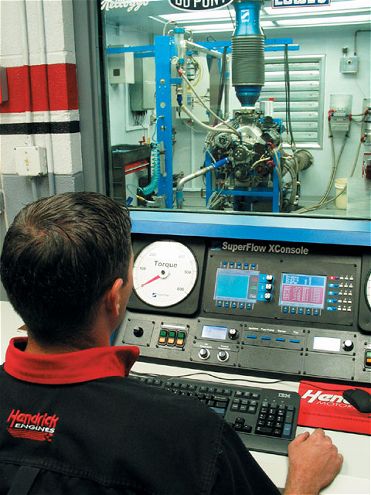 Hendrick Motorsports puts approximately 800 engines on the dyno per year and struggles to control the same variables that you do to get good, dependable information.
Hendrick Motorsports puts approximately 800 engines on the dyno per year and struggles to control the same variables that you do to get good, dependable information.
If you've been in racing any amount of time at all, you know an engine dynomometer is vastly more useful as a tuning tool than for producing a single max-horsepower number for bragging rights at the track. Whether you're doing the work yourself or paying an engine builder to do it for you, a dyno can help tune an engine to your needs.
You can map out the powerband to determine the best gearing; finesse the torque curve to make the power produced more tractable; and even experiment with air/fuel ratios, timing, and fluid temperatures to determine what a particular engine likes best. (We all know no matter how you try to build two engines exactly alike, they always have their own personalities.)
These are fine-tuning steps--meaning you're often dealing with fractions of horsepower. Plus, given the restrictive rules in almost every class of stock car racing today, most engine builders admit all the big gains have been found. The winner in today's horsepower race is the one who can uncover the most "little" gains. Again, we are talking about fractional bumps on the horsepower scale.
It all leads to the question: How reliable are your dyno numbers?
It's relatively easy to get shifting numbers from different dyno runs at different times not because the equipment is poor or difficult to use, but because there are so many variables that can drastically affect an engine's output. Everything from the obvious (air/fuel ratio, air temperature, oil temperature) to things that may not be quite so obvious (barometric pressure, contaminants in the air, how the dyno controls are operated, different batches of fuel) has to be considered. The key is to control as many variables as possible; by keeping them constant from one test to the next, they cannot contaminate the data.
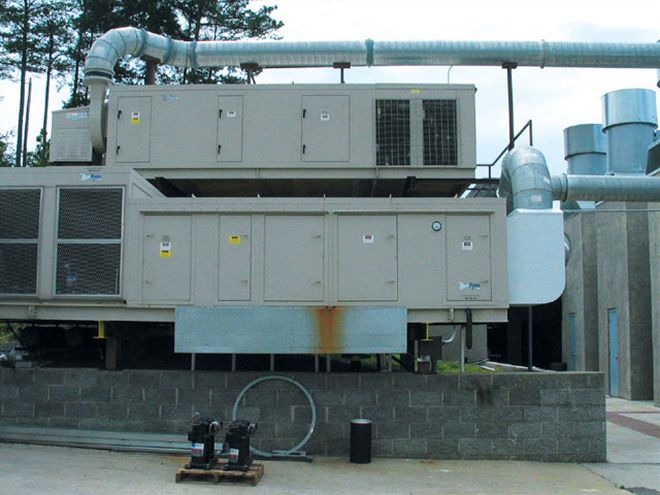 Hendrick Motorsports uses this giant air conditioning unit to prepare the combustion air for two dyno units. The air is controlled for temperature, humidity, and pressure.
Hendrick Motorsports uses this giant air conditioning unit to prepare the combustion air for two dyno units. The air is controlled for temperature, humidity, and pressure.
Of course, that's easier said than done. Before you begin controlling variables, you have to identify them and determine a way to measure and track them. "Measuring the variables is part of the issue of getting to control the variables," explains Harold Bettes of Superflow. "In the good old days, it was easier because we simply didn't worry about a lot of those things. There were fewer gauges then, so therefore, less problems. But come to find out, those things we weren't measuring were equally important to those things we were-sometimes more."
Rob Benson heads up the dyno department for Hendrick Motorsports' engine division and is the proprietor of one of the most state-of-the-art systems anywhere on the planet. With seven Winston Cup teams (four in-house) and at least one Busch Series team to support, approximately 800 complete engines will be built at Hendrick Motorsports this year, and every single one will see dyno time. Because of the enormous stakes involved with a poorly performing or broken engine at this level, you can bet Benson is fanatical about the information he gathers from every dyno pull.
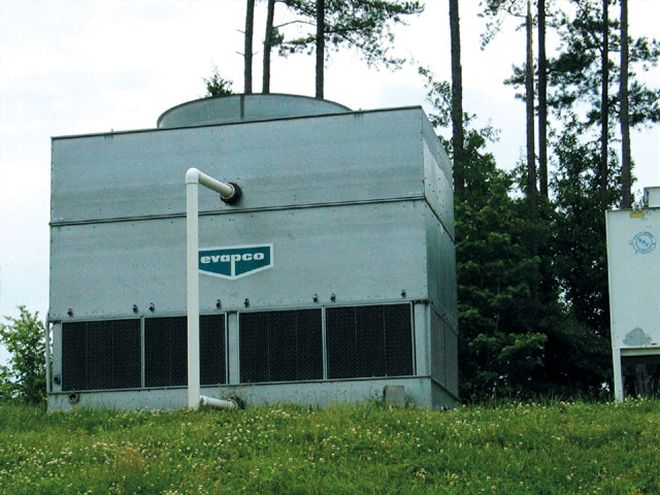 Even the temperature of the water in the water brake is important. Because Hendrick Motorsports' dynos are running almost constantly, they use a cooling tower. You may not need to go to this extreme, but it's important to keep the water in the dyno brake within a controllable range, no matter how many engines you do.
Even the temperature of the water in the water brake is important. Because Hendrick Motorsports' dynos are running almost constantly, they use a cooling tower. You may not need to go to this extreme, but it's important to keep the water in the dyno brake within a controllable range, no matter how many engines you do.
"The major component is to control the temperatures," he says. "We try to limit the number of pulls we put on a race engine and make sure when we do our pulls all the temperatures for the air and fluids are within a set range. We try to hold the water temp to within two degrees Fahrenheit and the oil to approximately the same range. We also measure the oil temp in and the oil temp out, which is usually 220 and 240. We even go so far as to control the temperature of the water used in the water brake, which is held within a range of 10 degrees.
"Of course, we've invested in a lot of equipment that allows us to maintain these parameters that an engine builder who isn't involved in Winston Cup probably doesn't have access to. It isn't critical that every engine builder stay within these limits to be successful, but it does give you an idea of how important it can be."
To give you an idea of what Benson is talking about, we've included several photos of one of his dynos and the environmental controls that go with it. Unless you are competing weekly with Hendrick Motorsports for NASCAR's Winston Cup, it's unlikely you can afford to duplicate this level of hardware. (One conditioning system designed solely to provide combustion air that is both temperature and pressure-controlled costs approximately $1,000 a month to operate.) The idea, however, is to emphasize the importance of chasing every variable possible.
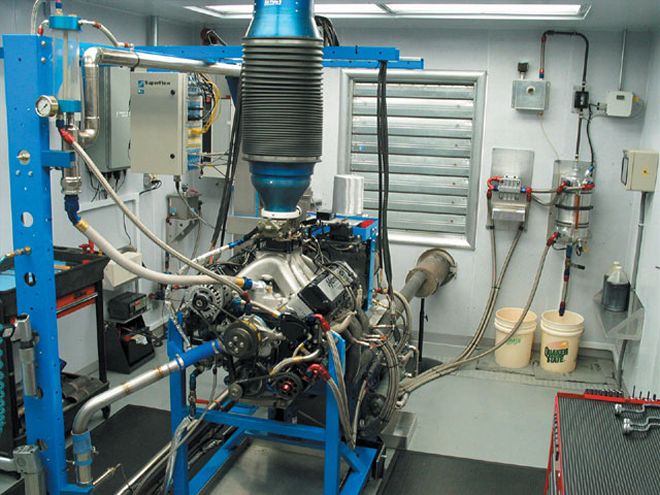 The interior of a Hendrick Motorsports dyno cell. The staff has the capability to even-measure cylinder blow-by in real time.
The interior of a Hendrick Motorsports dyno cell. The staff has the capability to even-measure cylinder blow-by in real time.
Keeping an eye on the temperature gauges that track an engine's fluids is easy. It's also fairly easy to track air temperature. It is harder, however, to know what is in the air going into the combustion chambers. Take, for example, the relative humidity; water doesn't burn, but it does take the place of oxygen, which does. The higher the humidity, the worse your engine is likely to perform. Are you tracking it from one run to the next?The easy solution for this is to pull the intake air from an air-conditioned room instead of the exterior of the building. This can help regulate both humidity and air temperature. But be careful where it is pulled from. Pulling the air from the dyno cell isn't a good idea because you want fans blowing plenty of air across the engine. Plus, if there is an exhaust leak, those burned hydrocarbons could be recycled back through the engine, which can harm performance.
Instead, pull the air from another room in the shop. Now the air is conditioned, relatively stable, and away from any contaminants the engine may be leaking into the dyno cell. Still, it's a good idea to look closely at exactly what's going on in that room to determine if there are any new contaminants entering the system. Now, instead of introducing contaminants that can harm performance, you may be accidentally introducing those that artificially enhance it. If someone is spray-painting the exterior of a block or blasting flammable cleaners, the overspray hangs in the air for quite some time. Try to find an area where this won't be a problem.
Finally, hang your air inlet about chest-level. Remember, hot air rises-it's important to be at the same level as the thermostat. Plus, airborne contaminants tend to either be lighter than air and rise, or heavier and sink to the floor. Mid-level air can often be the cleanest.
Don't forget about the biggest source of variables in the entire dyno room-the operator. Eliminating the variables involved doesn't require locking everybody out of your dyno cell (although it has been done before). It simply means to establish a set of procedures for dynoing an engine and stick with it religiously. These steps should include everything from attaching the engine to the test stand, to checking the fuel and how the sequence of tests will be run on the dyno.
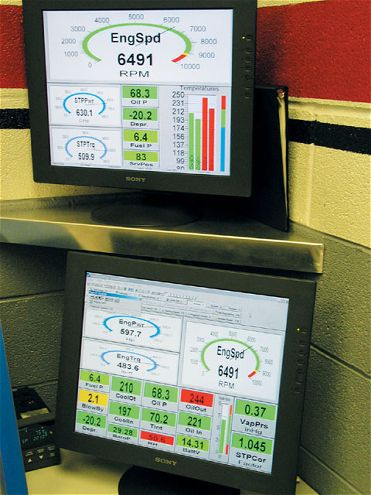
"Procedures are just as important as controlling data," Bettes says. "Consider something so simple as how rapidly you apply the throttle before you begin the test. What just happened? Well, if we do it too fast, we stick a whole bunch of accelerator pump to it and it wets the manifold. Now, how long does that take to clean out of the system? I don't know, but it does take some time. It is another variable that you have just introduced. You have to have consistency to get consistency.
At least once, you've probably heard a racer complain that an engine looked great on the dyno but ran like a dog once it was in the race car. Often it's regarded as an unexplainable mystery, but that is really not the case. Kevin Hamilton, Land and Sea's dynomometer technical sales representative, says the engine's poor performance is almost always attributed to a difference between the engine's support systems on the dyno and in the car.
Support systems include anything the engine needs to run: the fuel system, the electrical system, exhaust pipes-you get the idea. Communication between the racer and the engine builder is a priority.
"It's not just about keeping things consistent on the dyno," Hamilton explains. "If you want the engine's output at the track to match what you saw on the dyno, you have to be completely consistent. That means the oil temperature has to stay in the same range, the fuel and electrical systems need to be the same-everything.
"Guys will run an engine with whatever type of header they have in the shop that fits, and then the customer will take it home and bolt on whatever header he had in the car with the last engine, and they will never discuss how the two compare. The customer and the engine builder have to work together. The engine builder has to be aware of what the customer plans to run with the engine and tune for that, and the customer has to be willing to make changes to better match what the engine builder has found works best for his engine. It all works together."